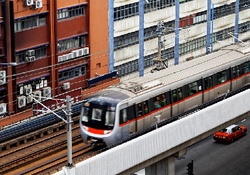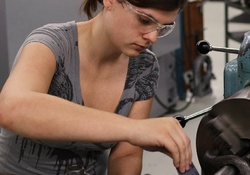In all the conversations you hear about going green, you’ve probably never heard about sustainable breathing. But chances are that while you read this article, you’re sitting in an office, subject to the whim of some mysterious ventilation unit that’s enabling your every breath. Unfortunately, chances also are that you’re not being a sustainable breather. Because with few exceptions, the hidden systems in the walls that keep you breathing comfortably at your desk have gargantuan carbon footprints.
Together with heat and air conditioning, its partners in indoor-airflow crime, ventilation makes up about half of the electricity use in each of America’s 140 million buildings. And since buildings account for 74 percent of all electricity use nationwide, boosting the sustainability index of that breathing-enabling machinery could work wonders—for our health, our wallets and the environment.
But you can’t be blamed for not knowing about the sustainable breathing movement, which advocates for eco-friendly indoor air quality, because the sustainable breathing movement doesn’t actually exist.
Its would-be spirit, however, mirrors the driving force behind a very real multibillion dollar movement—green retrofitting—that’s been coalescing over the past 20 years to combat the energy inefficiency of our homes and offices. Low-flow toilets. Double-pane windows. Low-water washing machines. Stack effect ventilation. Solar-paneled rooftops. From an art museum in Virginia to an elementary school in Philadelphia, with millions of buildings in between, homeowners and landlords across the country are asking themselves the same question: Is it worth it to retrofit?
While the clear-cut answer for every building remains a moving target, the consensus moves closer to a resounding “yes” with each passing year.
Take the case of the Virginia Museum of Fine Art. First built in 1936, the museum houses 22,000 pieces of art, some of which are more than 5,000 years old, which means the temperature and humidity of the building matters slightly more than it does for most buildings. A few ticks of the thermometer too high and millions of dollars’ worth of art could be lost.
As the building expanded four times over fifty years, adding on new piping to old pumps, its growth outgrew the building’s aging infrastructure. But in 2010, with plans to add a new library, café and atrium to the building, the museum turned to retrofitting to safeguard its artwork and reduce costs, while meeting a statewide governor’s order to reduce energy consumption.
By partnering with Siemens to install new patent-pending chiller plants—the behind-the-scenes hardware that keeps us cool indoors—the Virginia Museum of Fine Art was able to maintain the humidity that it needs indoors, cut energy use by up to 50 percent and save up to $250,000 per year.
That kind of renovation is part of a movement that’s steadily gaining momentum. As of last year, the U.S. Green Building Council estimated that 4.3 million people live and work in buildings with LEED certification—the certification of record in sustainable construction—and more than 6.2 million experience one of them every day. According to a 2014 report by Navigant Consulting, you can expect that number to balloon in the next decade, with its projection for the commercial retrofitting market to reach $127 billion by 2023.
Because building owners need to spend quite a bit of money up front to harvest all those future energy savings, they’re turning to the companies that do the retrofitting for deals. In Houston, for example, the city government awarded a $12.3 million contract to Siemens to retrofit its buildings, streets and parks with a guarantee that the savings would pay off the cost of the project and more within ten years. “Hard savings are quantifiable,” said Jeff Wills, a Product portfolio manager for Siemens. “You can look at energy bills, and countless studies have been done on how being energy efficient saves money and resources.” Any shortfall in savings and Siemens would pay Houston back the difference. A similar savings-guaranteed agreement was arranged between the companies involved in the retrofitting of the Virginia Museum of Fine Art.
But while the energy savings from green retrofitting are a wonderful thing, commercial property owners say, it’s the somewhat posh side effects that can lead them to follow through: increased natural light that removes the need for constant artificial lighting; automatic lights that switch on and off on demand; high-tech infrastructure that essentially gamifies energy efficiency.
These core sustainability features have the happy byproduct of creating spaces that are pleasant to spend time in, which gives property owners the green light to charge higher rents. Meanwhile, businesses are happy to pay the premium for an eco-friendly workspace that keeps their employees in the office. “If you get a 10 percent increase in productivity, you have saved their rent,” said David Pogue, national director of sustainability for the CBRE commercial real estate firm, in the Urban Land roundtable.
Green retrofitting has also found a particularly strong embrace from the U.S.’s education system, where the same productivity gains that drive revenue in office buildings offer students better opportunities to learn in schools.
According to a McGraw-Hill Construction study, an astonishingly high 83 percent of surveyed K-12 schools have conducted at least some type of retrofitting in the last three years. Another finding from the study offers a clue as to why they’re so eager to adopt the practice: Nine out of 10 schools reported that they believe green schools improve their students’ health and well-being—and, by association, their ability to learn.
In 2008, one in four students attending Thurgood Marshall Elementary School in Philadelphia suffered from asthma or had been admitted into a hospital for wheezing—a rate more than two times the national average. In a retrofit done in partnership with the U.S. Green Building Council, inspectors discovered that the ventilation system needed significant updating to meet the standard for the amount of outside air that flowed through the school’s vents. They fixed all 60 vents throughout the school and installed sustainable faucets and fixed roof leaks. They updated heating and air conditioning systems.
These are updates that likely should have been made whether it was good for the environment or not. But in meeting the challenge with green retrofitting, they gave their students a healthy learning environment while also minimizing the school’s energy footprint. And in doing so, they also transformed their disproportionately asthmatic students into sustainable breathers.





